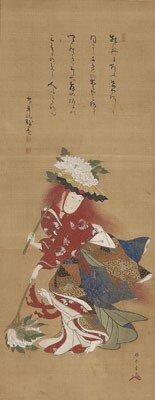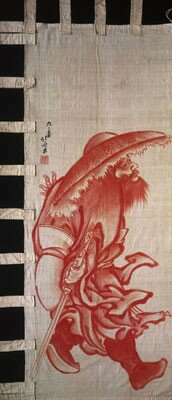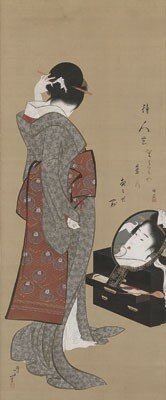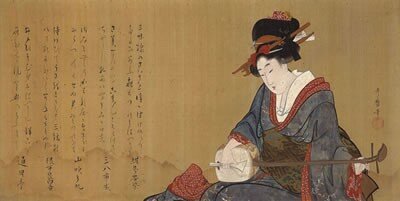Drama and Desire: Japanese Paintings from the Floating World 1690–1850 au San Francsico Asian Art Museum
Collection of Suggestive Pictures (detail), about late Tenmei (1781–1789) or early Kansei (1789–1801) era, by Katsukawa Shuncho (active about 1781–1801). Handscroll; ink, color, gold, and mica on silk. William Sturgis Bigelow Collection.
Living only for the moment, turning our full attention to the pleasures of the moon, the snow, the cherry blossoms and the maple leaves; singing songs, drinking wine, diverting ourselves in just floating, floating: caring not a whit for the pauperism staring us in the face, refusing to be disheartened, like a gourd floating along with the river current: this is what we call the floating world . . .
—Tales of the Floating World (Ukiyo Monogatari),
approx. 1661, by Asai Ryoi
They lived for the moment: beautiful geisha, flamboyant actors, seductive courtesans. Meet the denizens of the "Floating World"—the theater and pleasure quarters of Japan's Edo period.
Paintings by masters of the era—Hokusai, Hiroshige, and others—captured the lives of the Floating World in vivid detail. Now, for the first time in more than 100 years, view 80 of these rare exquisite paintings from the unrivaled collection of the Museum of Fine Arts, Boston. Mingle with beauties in an intimate world of sumptuous colors and stylish surroundings.
Shakkyo, the Lion Dance, around 1787–1788, by Katsukawa Shunsho (Japanese, 1726–1792). Hanging scroll; ink, color, and gold on silk. William Sturgis Bigelow Collection.
The Floating World and Ukiyo-e
Edo (modern-day Tokyo), which was founded in the early seventeenth century as a feudal military enclave by the shogun Tokugawa Ieyasu, was known as the “castle town under heaven.” During the next 100 years, it developed into the country’s major political and commercial center. By the mid-eighteenth century, Edo was one of the largest cities in the world, with more than one million inhabitants, but it was still very much a brutish, male-dominated society. To escape from the hardships of daily life and to suspend reality if only for a moment, the male residents of Edo would go to theaters in the city or travel to the Yoshiwara—a gated, licensed brothel district located on the outskirts. There they could engage in pleasurable pursuits, which included attending Kabuki theater and musical presentations, composing poetry as part of literary groups, and rendezvousing with courtesans at well-appointed houses of assignation (ageya). These places were also known collectively as the “floating world.”
Against this lively backdrop, a new genre of painting—ukiyo-e—developed. Masters of ukiyo-e depicted everyday activities of the city’s inhabitants and detailed the stylish preoccupations of the pleasure quarters. While a Western audience is more familiar with the mass-produced woodblock prints of this era, artists of the time also created carefully executed colorful paintings for their more affluent patrons. These paintings depict elegant interiors with beautifully dressed courtesans, expressive portraits of Kabuki actors, and detailed accounts of contemporary life in Edo. Generally commissioned by wealthy merchants, samurai families, and even members of the imperial family, the paintings in Drama and Desire reveal the unique style and splendor of an art that celebrates one of the most alluring aspects of Japanese culture.
Japanese ukiyo-e paintings were executed on paper and silk using mineral pigments with a glue binder for paints and carbon from soot for inks. Fragile and sensitive to light, they were not meant for permanent display. Screens and hanging scrolls were shown only at specific times of the year. Handscrolls were treated as books to be brought out and enjoyed intimately, then put away. The exclusive nature and fragility of the ukiyo-e paintings account for their rarity today.
Zhong Kui, the Demon Queller, about 1805, by Katsushika Hokusai (Japanese, 1760–1849). Painted banner; color with ink on cotton. William Sturgis Bigelow Collection.
The Asian Art Museum’s presentation of Drama and Desire is divided into three sections: Enjoyments of the Four Seasons; Dance, Drama, and Kabuki Theater; and The Pleasure Quarters, Courtesans, and Geisha. The first section, Enjoyments of the Four Seasons, explores the leisurely pursuits of Edo residents throughout the year. Living in crowded conditions, they enjoyed spending their free time along the unspoiled banks of the Sumida River and in the large precincts surrounding temples and shrines. In the spring, people walked along the river picking flowers. In the summer, they strolled about and rode in boats enjoying cool breezes, delighted in fireworks near the Ryogoku Bridge and participated in neighborhood events such as dancing in the streets. In the autumn, they enjoyed viewing the full moon from boats and from their balconies, and sought out maple trees with leaves of changing colors. Even winter was enjoyable, with its views of fallen snow. Ukiyo-e painters captured these activities in wonderful detail.
Scenes of Amusement in Spring and Summer by Katsukawa Shunsho (1726-1792) conveys a pleasurable sense of the seasons. In the first screen the artist presents a bird’s-eye view of a riverbank on a warm spring day. Scattered clusters of people enjoy the weather. Some admire the blossoming cherry trees; others pick spring herbs. In the second screen, green willow branches blowing in the breeze suggest early summer. One woman lounges behind bamboo blinds, others smoke pipes on the veranda or fish at a pond. Generally ukiyo-e artists painted on a small scale such as handscrolls and hanging scrolls. The large scale of these screens by Shunsho—each 55 1/2” x 134 ¼”—suggest they were commissioned by a wealthy client.
The section entitled Dance, Drama, and Kabuki Theater focuses on the arts of the stage. A pair of six-panel folding screens by Hishikawa Moronobu (died 1694), entitled Scenes from the Nakamura Kabuki Theater and Scenes from the Yoshiwara Pleasure Quarter, provides insight into the theater world. In the right screen a lively troupe of actors (in male and female roles) wends its way across the stage to the accompaniment of a samisen and other instruments while additional vignettes show preparations backstage and barkers at the entrance corralling passersby to attend the performance. In the left screen, the artist provides a panoramic view of Nakano-cho, the broad main avenue of the Yoshiwara Pleasure Quarter. In the lower section of the fourth panel, a crowd has gathered to watch the pageantry of a courtesan and her entourage parading down the street to meet her client. Other scenes include courtesans and geisha dancing and playing musical instruments to entertain their guests. Theater signboards, which were the posters of their times, are also displayed in this section. All four of the boldly painted advertisements on display, with celebrated actors shown in dramatic poses from particular Kabuki plays, are substantially earlier than any examples remaining in Japan.
Most familiar in the West for his print series Thirty-six Views of Mount Fuji, Katushika Hokusai (1760-1849) was also recognized during his lifetime for his dramatic lanterns, made to line the grounds of local shrines and the pleasure quarters during annual festivals. Two of the lanterns are on display in the theater section of the exhibition, each of which depicts a dragon, representing the male principle, in confrontation with a tiger on one and a snake on another, representing the female principle. This yin and yang symbolism is dynamic, without beginning or end, as the creatures chase each other around the surfaces of the lanterns. During the nineteenth century, these paintings were dismantled and flattened for preservation. Recently, their three-dimensional forms were restored by MFA conservators.
Three Women Playing Musical Instruments, about Bunsei (1818--–1830) to Tenpo (1830–1844) era, by Katsushika Oi (Japanese, active about 1818–after 1854). Hanging scroll; ink and color on silk. William Sturgis Bigelow Collection.
The grand finale of Drama and Desire features the revered heroines of the floating world and their environs in a section of the exhibition entitled The Pleasure Quarters, Courtesans, and Geisha. Ukiyo-e artists captured the beauty and style of these archetypical objects of desire in provocative detail. When making sets of three hanging scrolls or three-sheet compositions of multicolored prints, ukiyo-e artists always gave a high-ranking Yoshiwara courtesan the place of honor in the middle, and flanked her with women from other parts of the pleasure quarters on the left and right. This order can also be found in sets of three hanging scrolls where women from town were included as subjects. The courtesan always held top rank in the middle, with town women flanking her on either side. The interpretation of this order suggests that courtesans were held in higher esteem than even married women and their daughters.
An impressive set of three hanging scrolls by Utagawa Toyoharu (1735-1814) entitled Courtesans with Snow, Moon, and Flowers exemplifies this order. The artist juxtaposes women from the different pleasure quarters in Edo with the traditional poetic theme of snow, moon, and flowers. The center scroll depicts the flower, a Yoshiwara courtesan in all her splendor. She wears a dramatic outer robe patterned with peacock feathers against a black ground. The fan in her left hand is decorated with cherry blossoms. The left scroll portrays a high-ranking prostitute in the unlicensed brothel district of Shingawa, also known as South Station, which was famous for moon-viewing. The final scroll on the right shows a geisha belonging to the unlicensed Fukagawa brothels. A lacquer tray to her left holds a mound of snow and the red charcoal brazier suggests the winter cold.
Also included in this section are three erotic artworks known as shunga, or “spring pictures.” This type of free-spirited, risqué composition of fantasy was produced by many of the leading ukiyo-e artists of the day, but because of Western sensibilities and censorship laws in modern day Japan, rarely have they been publicly exhibited. The works on view include Collection of Suggestive Pictures by Katsukawa Shuncho (active about 1781-1801), the leading painter of images of beautiful images in the 1780s and 1790s.
Woman Looking at Herself in a Mirror, about 1805, by Katsushika Hokusai (Japanese, 1760–1849). Hanging scroll; ink, color, and gold on silk. William Sturgis Bigelow Collection.
About the Ukiyo-e Collection at the Museum of Fine Arts, Boston
In the mid-19th century, contemporary European and American connoisseurs were eager to form extensive collections of ukiyo-e, but their access was primarily limited to woodblock prints. The costly, individualized paintings of the type displayed in Drama and Desire were rare outside Japan. In light of this, the Museum of Fine Arts, Boston is particularly fortunate to have amassed the most comprehensive collection of these important paintings. Largely acquired through the efforts of Boston physician William Sturgis Bigelow (1850-1926) during his residence in Japan in the 1880s, the museum's collection of ukiyo-e painting numbers more than 700 artworks. Included are superb paintings by all of the major masters from the 17th through the mid-19th centuries.
In 1996–1997, the curatorial staff in Japanese art at the MFA collaborated with a team of Japanese scholars in cataloguing the institution's holdings of ukiyo-e paintings for the first time. Such an evaluation of the collection had not been conducted since the early 20th century tenure of Okakura Kakuzo, curator of Japanese art from 1904 to 1913. With the completion of the project, the Boston collection of ukiyo-e painting was declared to be the finest anywhere in the world. So important was this cataloguing project, the scholars who participated in the survey stated, “The results [necessitate] a rethinking of Japanese art history.” After 10 years of research, conservation, and planning, the museum is finally bringing highlights of this unparalleled collection to museum visitors worldwide.
Young Woman Playing the Shamisen, about Bunka (1804–1806), by Kitagawa Utamaro I (Japanese, 1753–1806). Hanging scroll; ink, color, and gold on silk. Fenollosa-Weld Collection.
(All exhibition images courtesy of the Museum of Fine Arts, Boston.)
 Drama and Desire: Japanese Paintings from the Floating World 1690-1850, published by MFA Publications and edited by MFA curator Anne Nishimura Morse, features essays and contributions by leading scholars of Japanese art. The fully illustrated catalog is available at the Asian Art Museum store. ($55 hardcover; $37.50 softcover). 415-581-3600 or shop@asianart.org
Drama and Desire: Japanese Paintings from the Floating World 1690-1850, published by MFA Publications and edited by MFA curator Anne Nishimura Morse, features essays and contributions by leading scholars of Japanese art. The fully illustrated catalog is available at the Asian Art Museum store. ($55 hardcover; $37.50 softcover). 415-581-3600 or shop@asianart.org
Drama and Desire: Japanese Paintings from the Floating World 1690–1850. San Francsico Asian Art Museum. 200 Larkin Street, San Francisco, CA 94102. Information: (415) 581-3500 or www.asianart.org

/https%3A%2F%2Fprofilepics.canalblog.com%2Fprofilepics%2F1%2F0%2F100183.jpg)
/https%3A%2F%2Fstorage.canalblog.com%2F03%2F02%2F119589%2F96711876_o.jpg)
/https%3A%2F%2Fstorage.canalblog.com%2F11%2F31%2F119589%2F94773502_o.jpg)
/https%3A%2F%2Fstorage.canalblog.com%2F20%2F83%2F119589%2F94772815_o.jpg)
/https%3A%2F%2Fstorage.canalblog.com%2F26%2F72%2F119589%2F75604929_o.jpg)
/https%3A%2F%2Fstorage.canalblog.com%2F59%2F60%2F119589%2F26458628_o.jpg)








/image%2F1371349%2F20240428%2Fob_096a92_telechargement-10.jpg)
/image%2F1371349%2F20240428%2Fob_d84f93_telechargement-8.jpg)
/image%2F1371349%2F20240428%2Fob_ad23da_telechargement-5.jpg)
/image%2F1371349%2F20240428%2Fob_dc7d3f_telechargement-3.jpg)